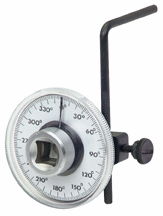I've seen a lot of questions on why a torque angle guage is needed for tightening the head bolts on the Bimmers. Since I was curious myself as to the real reasons for it, and not satisfied with "That's just how it's done.", I researched it further. Hopefully the following explanation will help anybody that has questions as to why this is done, and why it is necessary.
Quoting a passage that I found simple and to the point (from http://www.mondello.com/Pages/Articles/1/1.htm) :
There are three types of procedures used for torquing: torque to yield/angle to turn; torque to maximum stretch yield; and torque to a specific torque number and hope it's correct.
Basically what it comes down to, is that torquing
with just torque values such as foot-pounds or newton-meters is at best
a guess at getting the torque correct. Depending on the type of fastener,
materials used for both the bolt and the part it screws in to, cleanliness
of the thread, lubrication used, TYPE of lubrication used, etc., the
torque between two "identical" fasteners can actually vary by as much as
35% (or more) with the torque wrench having the same setting for both fasteners!
Many fasteners, such as wheel studs, water pump
bolts, etc., are just there to make sure that the bolt is probably tight
enough, and probably not too tight. These are the bolts that you
reuse over and over without any problems.
Head bolts, as well as most of the bolts internal to the engine, are what are called stretch bolts (also known as torque-to-yield bolts). These are designed to be tightened to the point they physically start to stretch, usually by a few thousandths of an inch. This leaves them in a elastic condition, that allows very equal clamping forces to be applied to the part they're holding down.
When you tighten one of these bolts, the torque setting
that is used is designed to get the bolt close to the point that it starts
to stretch. The torque angle guage is then used to put the bolt PAST the
point it starts to stretch and actually start to stretch it. You
just can't accurately measure this with a regular torque wrench, thus the
torque-to-yield/angle-to-turn method. The Maximum stretch yield method
doesn't apply here, since you need A) A very accurate micrometer to
measure the actual bolt stretch, and B) Access to both sides of the bolt,
which you don't have on head bolts.
 The torquing process is quite simple. You simply torque the bolt
using a normal torque wrench to a pre-determined torque. Then, usually
you'll warm things up by running it at idle, then let it cool back down
and re-torque again with the torque wrench. After that part is done,
the torque angle guage comes into play. The torque that the bolts
are at after the regular wrench is theoretically just before the bolt starts
to stretch. This accuracy depends of course on the factors mentioned
above. To get the final torque AND stretch on the bolt, you
tighten the bolt a given number of degrees of rotation. This is what
the torque angle guage is for, accurately measuring the degrees of additional
rotation (typically accurate to a degree or so).
The torquing process is quite simple. You simply torque the bolt
using a normal torque wrench to a pre-determined torque. Then, usually
you'll warm things up by running it at idle, then let it cool back down
and re-torque again with the torque wrench. After that part is done,
the torque angle guage comes into play. The torque that the bolts
are at after the regular wrench is theoretically just before the bolt starts
to stretch. This accuracy depends of course on the factors mentioned
above. To get the final torque AND stretch on the bolt, you
tighten the bolt a given number of degrees of rotation. This is what
the torque angle guage is for, accurately measuring the degrees of additional
rotation (typically accurate to a degree or so).
The Reason For Not Re-Using Stretch Bolts
The reason is quite simple. Once you have stretched the bolt once, it never returns to its original size. This weakens the bolt, and if you try to re-use it, you take a risk of snapping the bolt in two, leaving the threaded part in the block, the top in your hand, and a complicated repair required. It's just not worth the risk to try to re-use old bolts.
You can get replacement bolts that are not designed to stretch at the torque required to hold the parts together.
There are two good reasons for using non stretch
bolts. You want to re-use them in the future, and/or you have an
engine that is either forced induction (745i running massive boost for
example) or very high compression. Since the bolt is already at it's
maximum stretch without losing strength, you don't want to put undue stress
on it from a high compression engine and take the risk of a blown head
gasket.
There is also a good reason for NOT using these
bolts, and staying with the original OEM style stretch bolts.
Non stretch bolts require retorquing after a few heat/cool cycles (usually
specified at around 5-6 cycles), and may have to re-torque them anywhere
from every 30k to 70k miles, depending on application. If you have
a normally asperated engine, there's just no reason to have to do the extra
work when normally you wouldn't touch the bolts again after they've been
done properly with regular OEM stretch bolts. Also, stretch
bolts tend to provide more consistent, even clamping pressure than the
solid bolts do.
Well, hopefully now you have an understanding on what stretch bolts are, what a torque angle guage is, and why you really do need one to properly tighten the OEM head bolts. As always, if you have any questions feel free to e-mail me at kd7olf@xmission.com.